Sergey Rachmaninov - Vespers, Op. 37, Liturgy of St John Chrysostom, Op. 31 (2007)
The Prague Philharmonic Choir; Jaroslav Brych, conductor; Soloists
EAC | FLAC | Image (Cue&Log) ~ 209 Mb | Mp3 (CBR320) ~ 166 Mb | Scans included
Classical, Sacred, Choral | Label: Praga Digitals | # PRD 350 043 | Time: 01:01:32
The Prague Philharmonic Choir; Jaroslav Brych, conductor; Soloists
EAC | FLAC | Image (Cue&Log) ~ 209 Mb | Mp3 (CBR320) ~ 166 Mb | Scans included
Classical, Sacred, Choral | Label: Praga Digitals | # PRD 350 043 | Time: 01:01:32
The Prague Philharmonic choir join over a dozen others who have recorded Rachmaninov’s All-Night Vigil, a work once thought the special property of the Russian choirs who are, of course, prominent in the lists. The Czechs sing it without a cantor, and more as a concert work than some of the others do. Though they take the famous scale in the Nunc dimittis, descending to a profound B flat, in their stride, they are not as sonorous as some others, and their particular contribution is to sing the music lightly and flexibly, with a lively response to the words. They have excellent sopranos, safe in intonation when attacking the exposed high entries in thirds which are a feature of the music, and a good tenor for the three numbers that involve him as a soloist. The Magnificat, with all its tempo changes and shifts of register, is expressively done, as are the light rhythms of ‘Blessed art Thou, O Lord’.



